Legal Risk Management Report: Assessing Risks in Construction
VerifiedAdded on 2021/05/27
|12
|2983
|24
Report
AI Summary
This report provides a comprehensive analysis of legal risk management within the context of a construction project, specifically the VPD construction project. It begins by identifying various assessable risks inherent in such projects, including continuity disruptions, on-site damages and accidents, design errors, overburdening legal compliance issues, payment delays, and force majeure events. For each risk, the report outlines potential control measures and recommendations to minimize their impact. The report then delves into alternative dispute resolution (ADR) methods, specifically arbitration and mediation, detailing their processes and benefits in resolving contract disputes. Finally, it concludes with recommendations to ensure the project is undertaken with minimized risks and the effective use of ADR methods for any potential conflicts. The report emphasizes the importance of vigilant supervision, safety protocols, competent professionals, legal compliance agencies, and force majeure clauses to mitigate legal and financial liabilities.
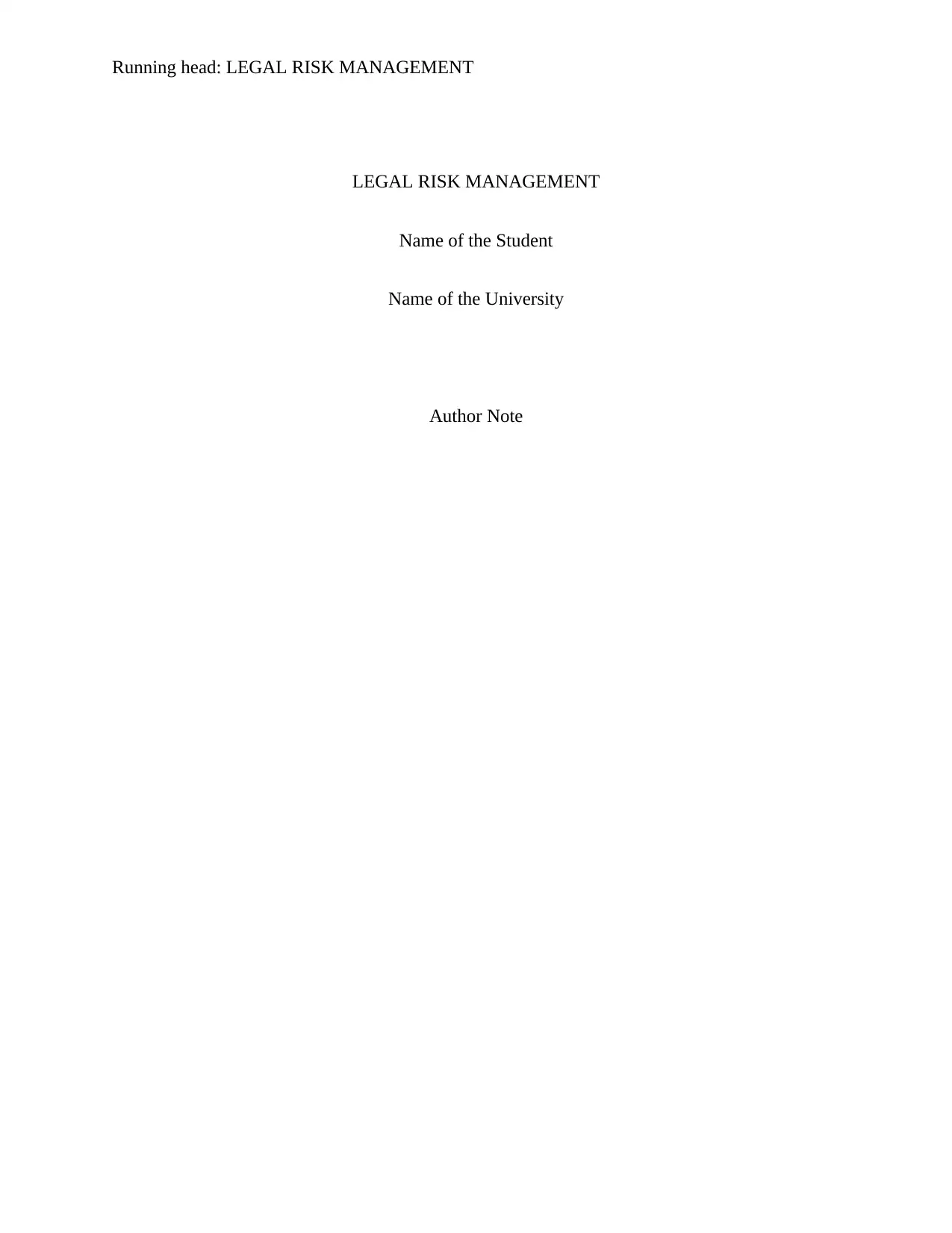
Running head: LEGAL RISK MANAGEMENT
LEGAL RISK MANAGEMENT
Name of the Student
Name of the University
Author Note
LEGAL RISK MANAGEMENT
Name of the Student
Name of the University
Author Note
Paraphrase This Document
Need a fresh take? Get an instant paraphrase of this document with our AI Paraphraser
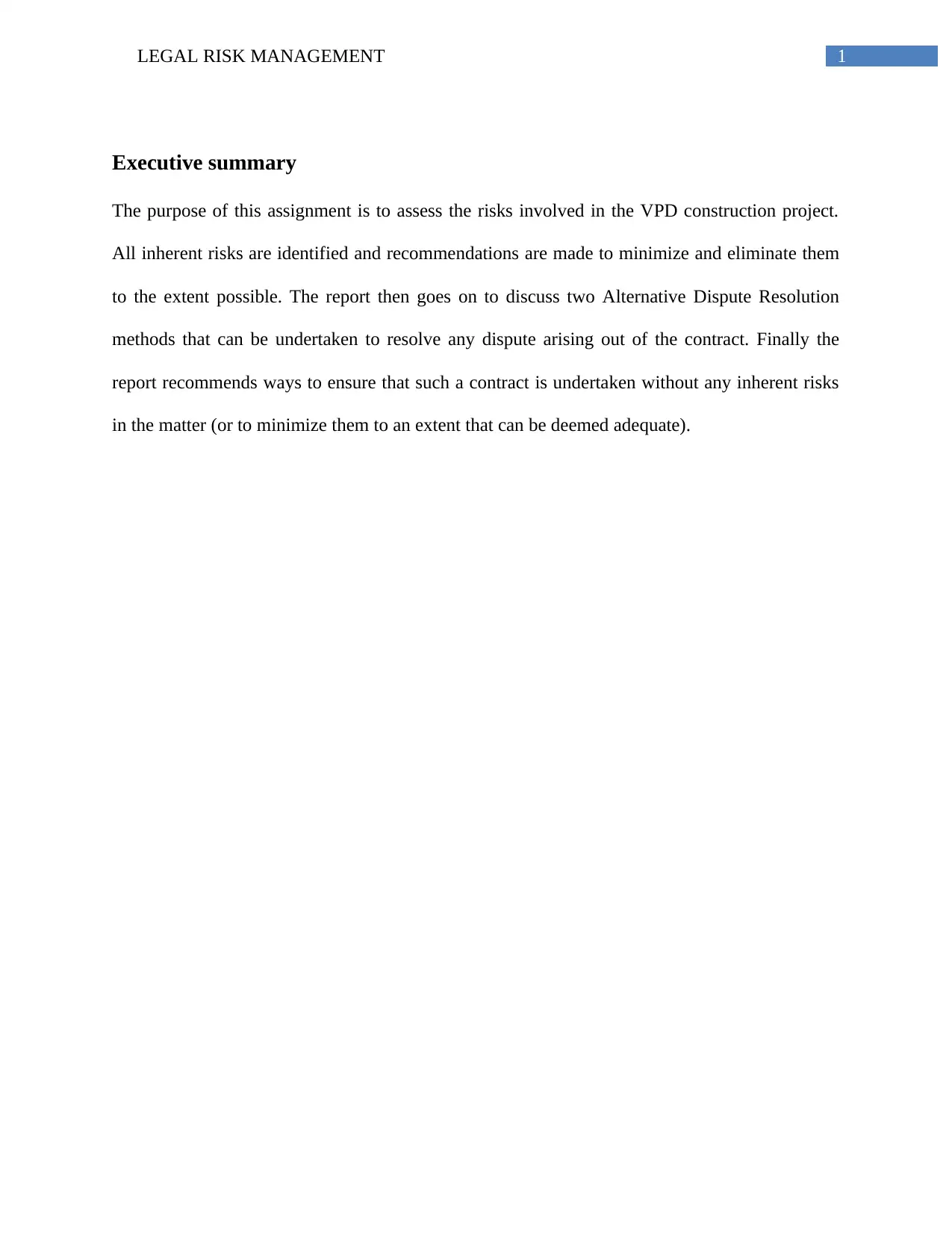
1LEGAL RISK MANAGEMENT
Executive summary
The purpose of this assignment is to assess the risks involved in the VPD construction project.
All inherent risks are identified and recommendations are made to minimize and eliminate them
to the extent possible. The report then goes on to discuss two Alternative Dispute Resolution
methods that can be undertaken to resolve any dispute arising out of the contract. Finally the
report recommends ways to ensure that such a contract is undertaken without any inherent risks
in the matter (or to minimize them to an extent that can be deemed adequate).
Executive summary
The purpose of this assignment is to assess the risks involved in the VPD construction project.
All inherent risks are identified and recommendations are made to minimize and eliminate them
to the extent possible. The report then goes on to discuss two Alternative Dispute Resolution
methods that can be undertaken to resolve any dispute arising out of the contract. Finally the
report recommends ways to ensure that such a contract is undertaken without any inherent risks
in the matter (or to minimize them to an extent that can be deemed adequate).
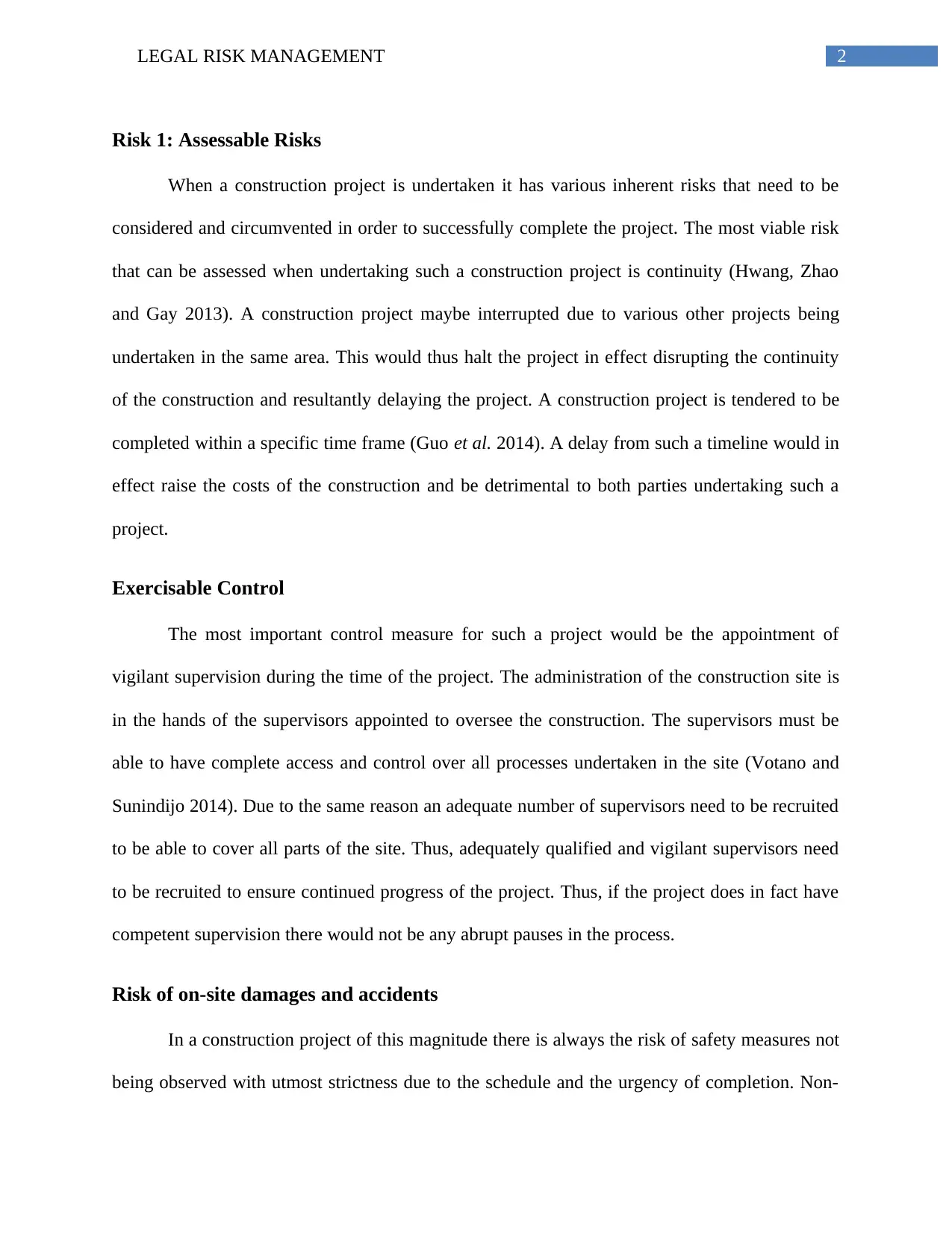
2LEGAL RISK MANAGEMENT
Risk 1: Assessable Risks
When a construction project is undertaken it has various inherent risks that need to be
considered and circumvented in order to successfully complete the project. The most viable risk
that can be assessed when undertaking such a construction project is continuity (Hwang, Zhao
and Gay 2013). A construction project maybe interrupted due to various other projects being
undertaken in the same area. This would thus halt the project in effect disrupting the continuity
of the construction and resultantly delaying the project. A construction project is tendered to be
completed within a specific time frame (Guo et al. 2014). A delay from such a timeline would in
effect raise the costs of the construction and be detrimental to both parties undertaking such a
project.
Exercisable Control
The most important control measure for such a project would be the appointment of
vigilant supervision during the time of the project. The administration of the construction site is
in the hands of the supervisors appointed to oversee the construction. The supervisors must be
able to have complete access and control over all processes undertaken in the site (Votano and
Sunindijo 2014). Due to the same reason an adequate number of supervisors need to be recruited
to be able to cover all parts of the site. Thus, adequately qualified and vigilant supervisors need
to be recruited to ensure continued progress of the project. Thus, if the project does in fact have
competent supervision there would not be any abrupt pauses in the process.
Risk of on-site damages and accidents
In a construction project of this magnitude there is always the risk of safety measures not
being observed with utmost strictness due to the schedule and the urgency of completion. Non-
Risk 1: Assessable Risks
When a construction project is undertaken it has various inherent risks that need to be
considered and circumvented in order to successfully complete the project. The most viable risk
that can be assessed when undertaking such a construction project is continuity (Hwang, Zhao
and Gay 2013). A construction project maybe interrupted due to various other projects being
undertaken in the same area. This would thus halt the project in effect disrupting the continuity
of the construction and resultantly delaying the project. A construction project is tendered to be
completed within a specific time frame (Guo et al. 2014). A delay from such a timeline would in
effect raise the costs of the construction and be detrimental to both parties undertaking such a
project.
Exercisable Control
The most important control measure for such a project would be the appointment of
vigilant supervision during the time of the project. The administration of the construction site is
in the hands of the supervisors appointed to oversee the construction. The supervisors must be
able to have complete access and control over all processes undertaken in the site (Votano and
Sunindijo 2014). Due to the same reason an adequate number of supervisors need to be recruited
to be able to cover all parts of the site. Thus, adequately qualified and vigilant supervisors need
to be recruited to ensure continued progress of the project. Thus, if the project does in fact have
competent supervision there would not be any abrupt pauses in the process.
Risk of on-site damages and accidents
In a construction project of this magnitude there is always the risk of safety measures not
being observed with utmost strictness due to the schedule and the urgency of completion. Non-
⊘ This is a preview!⊘
Do you want full access?
Subscribe today to unlock all pages.

Trusted by 1+ million students worldwide
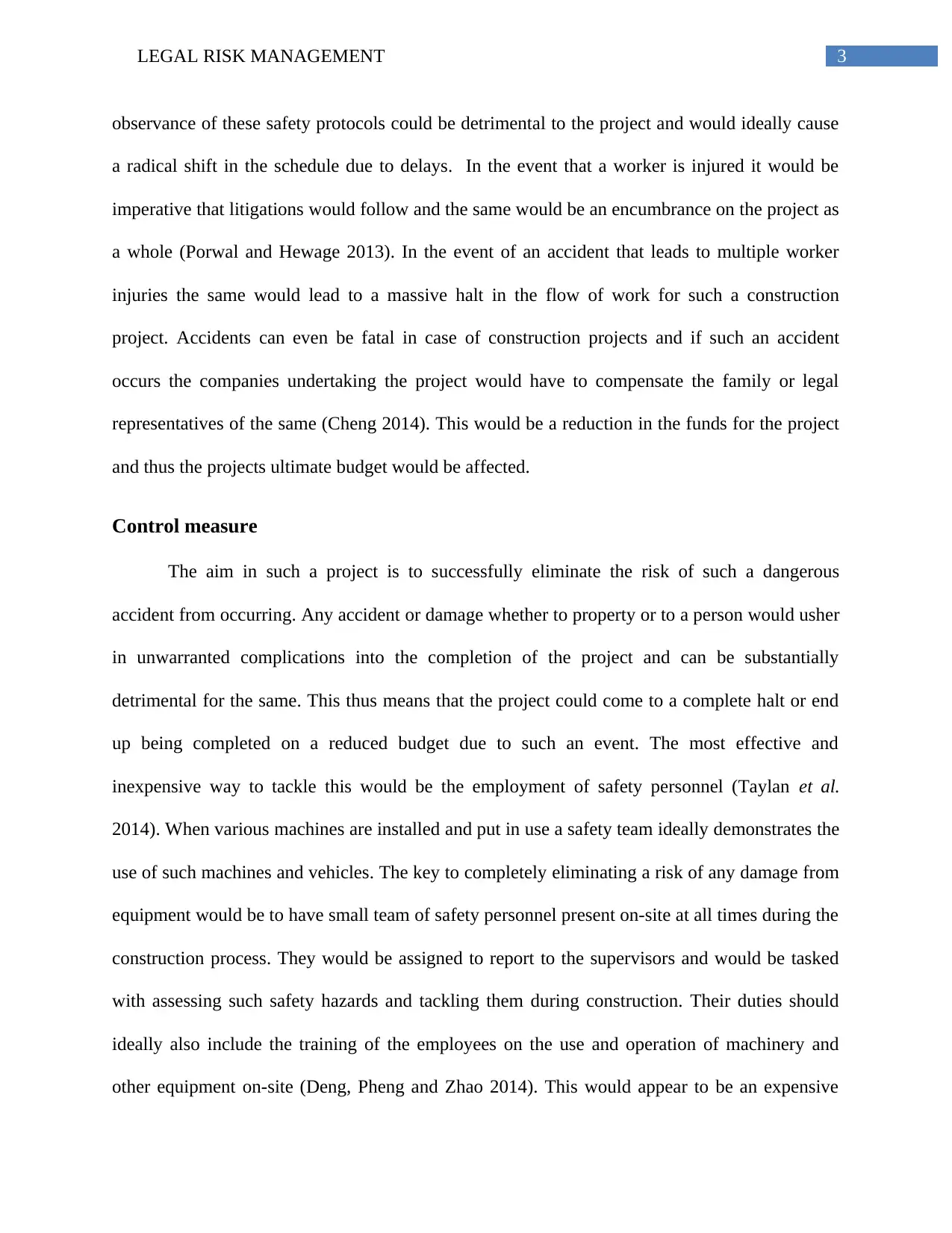
3LEGAL RISK MANAGEMENT
observance of these safety protocols could be detrimental to the project and would ideally cause
a radical shift in the schedule due to delays. In the event that a worker is injured it would be
imperative that litigations would follow and the same would be an encumbrance on the project as
a whole (Porwal and Hewage 2013). In the event of an accident that leads to multiple worker
injuries the same would lead to a massive halt in the flow of work for such a construction
project. Accidents can even be fatal in case of construction projects and if such an accident
occurs the companies undertaking the project would have to compensate the family or legal
representatives of the same (Cheng 2014). This would be a reduction in the funds for the project
and thus the projects ultimate budget would be affected.
Control measure
The aim in such a project is to successfully eliminate the risk of such a dangerous
accident from occurring. Any accident or damage whether to property or to a person would usher
in unwarranted complications into the completion of the project and can be substantially
detrimental for the same. This thus means that the project could come to a complete halt or end
up being completed on a reduced budget due to such an event. The most effective and
inexpensive way to tackle this would be the employment of safety personnel (Taylan et al.
2014). When various machines are installed and put in use a safety team ideally demonstrates the
use of such machines and vehicles. The key to completely eliminating a risk of any damage from
equipment would be to have small team of safety personnel present on-site at all times during the
construction process. They would be assigned to report to the supervisors and would be tasked
with assessing such safety hazards and tackling them during construction. Their duties should
ideally also include the training of the employees on the use and operation of machinery and
other equipment on-site (Deng, Pheng and Zhao 2014). This would appear to be an expensive
observance of these safety protocols could be detrimental to the project and would ideally cause
a radical shift in the schedule due to delays. In the event that a worker is injured it would be
imperative that litigations would follow and the same would be an encumbrance on the project as
a whole (Porwal and Hewage 2013). In the event of an accident that leads to multiple worker
injuries the same would lead to a massive halt in the flow of work for such a construction
project. Accidents can even be fatal in case of construction projects and if such an accident
occurs the companies undertaking the project would have to compensate the family or legal
representatives of the same (Cheng 2014). This would be a reduction in the funds for the project
and thus the projects ultimate budget would be affected.
Control measure
The aim in such a project is to successfully eliminate the risk of such a dangerous
accident from occurring. Any accident or damage whether to property or to a person would usher
in unwarranted complications into the completion of the project and can be substantially
detrimental for the same. This thus means that the project could come to a complete halt or end
up being completed on a reduced budget due to such an event. The most effective and
inexpensive way to tackle this would be the employment of safety personnel (Taylan et al.
2014). When various machines are installed and put in use a safety team ideally demonstrates the
use of such machines and vehicles. The key to completely eliminating a risk of any damage from
equipment would be to have small team of safety personnel present on-site at all times during the
construction process. They would be assigned to report to the supervisors and would be tasked
with assessing such safety hazards and tackling them during construction. Their duties should
ideally also include the training of the employees on the use and operation of machinery and
other equipment on-site (Deng, Pheng and Zhao 2014). This would appear to be an expensive
Paraphrase This Document
Need a fresh take? Get an instant paraphrase of this document with our AI Paraphraser
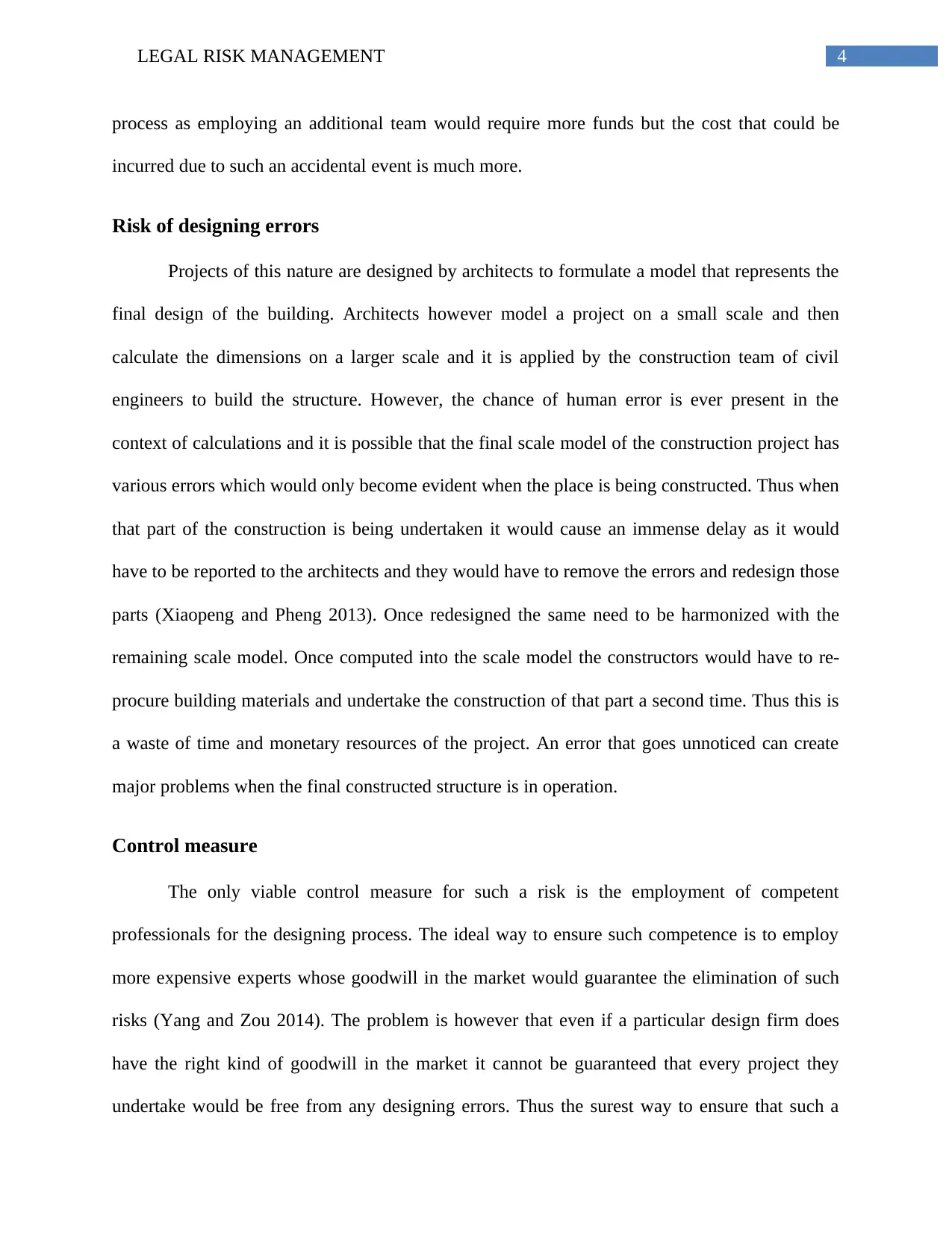
4LEGAL RISK MANAGEMENT
process as employing an additional team would require more funds but the cost that could be
incurred due to such an accidental event is much more.
Risk of designing errors
Projects of this nature are designed by architects to formulate a model that represents the
final design of the building. Architects however model a project on a small scale and then
calculate the dimensions on a larger scale and it is applied by the construction team of civil
engineers to build the structure. However, the chance of human error is ever present in the
context of calculations and it is possible that the final scale model of the construction project has
various errors which would only become evident when the place is being constructed. Thus when
that part of the construction is being undertaken it would cause an immense delay as it would
have to be reported to the architects and they would have to remove the errors and redesign those
parts (Xiaopeng and Pheng 2013). Once redesigned the same need to be harmonized with the
remaining scale model. Once computed into the scale model the constructors would have to re-
procure building materials and undertake the construction of that part a second time. Thus this is
a waste of time and monetary resources of the project. An error that goes unnoticed can create
major problems when the final constructed structure is in operation.
Control measure
The only viable control measure for such a risk is the employment of competent
professionals for the designing process. The ideal way to ensure such competence is to employ
more expensive experts whose goodwill in the market would guarantee the elimination of such
risks (Yang and Zou 2014). The problem is however that even if a particular design firm does
have the right kind of goodwill in the market it cannot be guaranteed that every project they
undertake would be free from any designing errors. Thus the surest way to ensure that such a
process as employing an additional team would require more funds but the cost that could be
incurred due to such an accidental event is much more.
Risk of designing errors
Projects of this nature are designed by architects to formulate a model that represents the
final design of the building. Architects however model a project on a small scale and then
calculate the dimensions on a larger scale and it is applied by the construction team of civil
engineers to build the structure. However, the chance of human error is ever present in the
context of calculations and it is possible that the final scale model of the construction project has
various errors which would only become evident when the place is being constructed. Thus when
that part of the construction is being undertaken it would cause an immense delay as it would
have to be reported to the architects and they would have to remove the errors and redesign those
parts (Xiaopeng and Pheng 2013). Once redesigned the same need to be harmonized with the
remaining scale model. Once computed into the scale model the constructors would have to re-
procure building materials and undertake the construction of that part a second time. Thus this is
a waste of time and monetary resources of the project. An error that goes unnoticed can create
major problems when the final constructed structure is in operation.
Control measure
The only viable control measure for such a risk is the employment of competent
professionals for the designing process. The ideal way to ensure such competence is to employ
more expensive experts whose goodwill in the market would guarantee the elimination of such
risks (Yang and Zou 2014). The problem is however that even if a particular design firm does
have the right kind of goodwill in the market it cannot be guaranteed that every project they
undertake would be free from any designing errors. Thus the surest way to ensure that such a
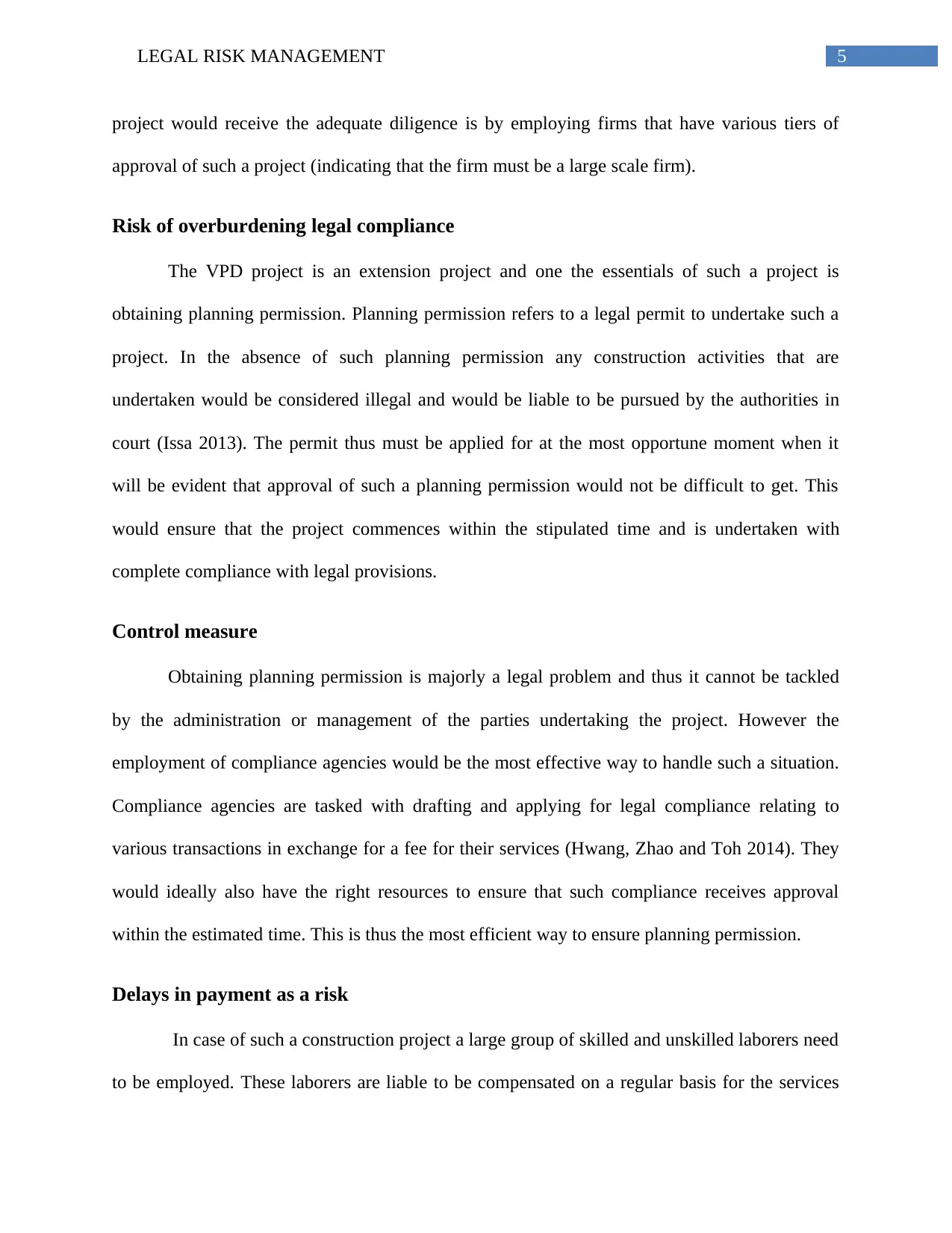
5LEGAL RISK MANAGEMENT
project would receive the adequate diligence is by employing firms that have various tiers of
approval of such a project (indicating that the firm must be a large scale firm).
Risk of overburdening legal compliance
The VPD project is an extension project and one the essentials of such a project is
obtaining planning permission. Planning permission refers to a legal permit to undertake such a
project. In the absence of such planning permission any construction activities that are
undertaken would be considered illegal and would be liable to be pursued by the authorities in
court (Issa 2013). The permit thus must be applied for at the most opportune moment when it
will be evident that approval of such a planning permission would not be difficult to get. This
would ensure that the project commences within the stipulated time and is undertaken with
complete compliance with legal provisions.
Control measure
Obtaining planning permission is majorly a legal problem and thus it cannot be tackled
by the administration or management of the parties undertaking the project. However the
employment of compliance agencies would be the most effective way to handle such a situation.
Compliance agencies are tasked with drafting and applying for legal compliance relating to
various transactions in exchange for a fee for their services (Hwang, Zhao and Toh 2014). They
would ideally also have the right resources to ensure that such compliance receives approval
within the estimated time. This is thus the most efficient way to ensure planning permission.
Delays in payment as a risk
In case of such a construction project a large group of skilled and unskilled laborers need
to be employed. These laborers are liable to be compensated on a regular basis for the services
project would receive the adequate diligence is by employing firms that have various tiers of
approval of such a project (indicating that the firm must be a large scale firm).
Risk of overburdening legal compliance
The VPD project is an extension project and one the essentials of such a project is
obtaining planning permission. Planning permission refers to a legal permit to undertake such a
project. In the absence of such planning permission any construction activities that are
undertaken would be considered illegal and would be liable to be pursued by the authorities in
court (Issa 2013). The permit thus must be applied for at the most opportune moment when it
will be evident that approval of such a planning permission would not be difficult to get. This
would ensure that the project commences within the stipulated time and is undertaken with
complete compliance with legal provisions.
Control measure
Obtaining planning permission is majorly a legal problem and thus it cannot be tackled
by the administration or management of the parties undertaking the project. However the
employment of compliance agencies would be the most effective way to handle such a situation.
Compliance agencies are tasked with drafting and applying for legal compliance relating to
various transactions in exchange for a fee for their services (Hwang, Zhao and Toh 2014). They
would ideally also have the right resources to ensure that such compliance receives approval
within the estimated time. This is thus the most efficient way to ensure planning permission.
Delays in payment as a risk
In case of such a construction project a large group of skilled and unskilled laborers need
to be employed. These laborers are liable to be compensated on a regular basis for the services
⊘ This is a preview!⊘
Do you want full access?
Subscribe today to unlock all pages.

Trusted by 1+ million students worldwide
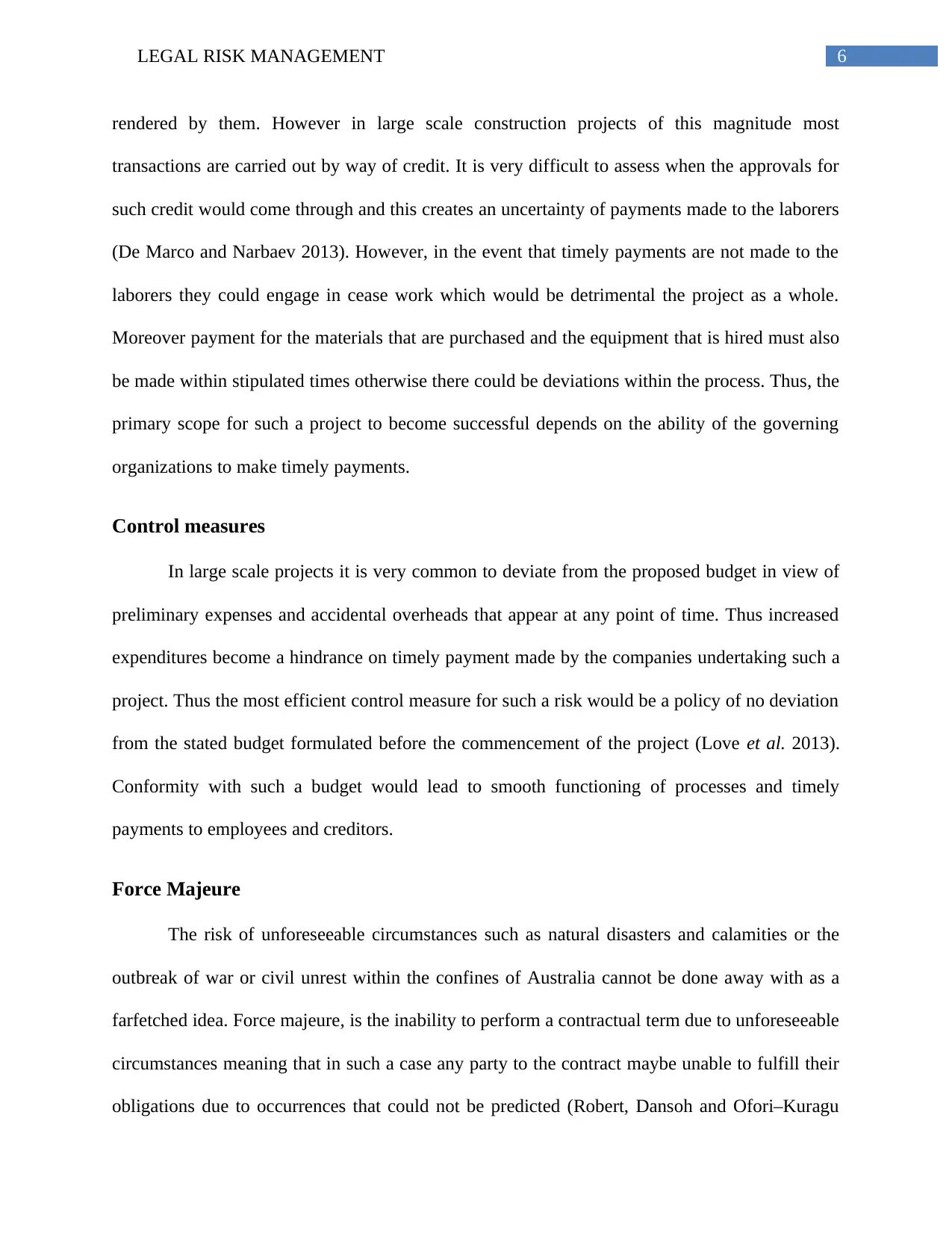
6LEGAL RISK MANAGEMENT
rendered by them. However in large scale construction projects of this magnitude most
transactions are carried out by way of credit. It is very difficult to assess when the approvals for
such credit would come through and this creates an uncertainty of payments made to the laborers
(De Marco and Narbaev 2013). However, in the event that timely payments are not made to the
laborers they could engage in cease work which would be detrimental the project as a whole.
Moreover payment for the materials that are purchased and the equipment that is hired must also
be made within stipulated times otherwise there could be deviations within the process. Thus, the
primary scope for such a project to become successful depends on the ability of the governing
organizations to make timely payments.
Control measures
In large scale projects it is very common to deviate from the proposed budget in view of
preliminary expenses and accidental overheads that appear at any point of time. Thus increased
expenditures become a hindrance on timely payment made by the companies undertaking such a
project. Thus the most efficient control measure for such a risk would be a policy of no deviation
from the stated budget formulated before the commencement of the project (Love et al. 2013).
Conformity with such a budget would lead to smooth functioning of processes and timely
payments to employees and creditors.
Force Majeure
The risk of unforeseeable circumstances such as natural disasters and calamities or the
outbreak of war or civil unrest within the confines of Australia cannot be done away with as a
farfetched idea. Force majeure, is the inability to perform a contractual term due to unforeseeable
circumstances meaning that in such a case any party to the contract maybe unable to fulfill their
obligations due to occurrences that could not be predicted (Robert, Dansoh and Ofori–Kuragu
rendered by them. However in large scale construction projects of this magnitude most
transactions are carried out by way of credit. It is very difficult to assess when the approvals for
such credit would come through and this creates an uncertainty of payments made to the laborers
(De Marco and Narbaev 2013). However, in the event that timely payments are not made to the
laborers they could engage in cease work which would be detrimental the project as a whole.
Moreover payment for the materials that are purchased and the equipment that is hired must also
be made within stipulated times otherwise there could be deviations within the process. Thus, the
primary scope for such a project to become successful depends on the ability of the governing
organizations to make timely payments.
Control measures
In large scale projects it is very common to deviate from the proposed budget in view of
preliminary expenses and accidental overheads that appear at any point of time. Thus increased
expenditures become a hindrance on timely payment made by the companies undertaking such a
project. Thus the most efficient control measure for such a risk would be a policy of no deviation
from the stated budget formulated before the commencement of the project (Love et al. 2013).
Conformity with such a budget would lead to smooth functioning of processes and timely
payments to employees and creditors.
Force Majeure
The risk of unforeseeable circumstances such as natural disasters and calamities or the
outbreak of war or civil unrest within the confines of Australia cannot be done away with as a
farfetched idea. Force majeure, is the inability to perform a contractual term due to unforeseeable
circumstances meaning that in such a case any party to the contract maybe unable to fulfill their
obligations due to occurrences that could not be predicted (Robert, Dansoh and Ofori–Kuragu
Paraphrase This Document
Need a fresh take? Get an instant paraphrase of this document with our AI Paraphraser
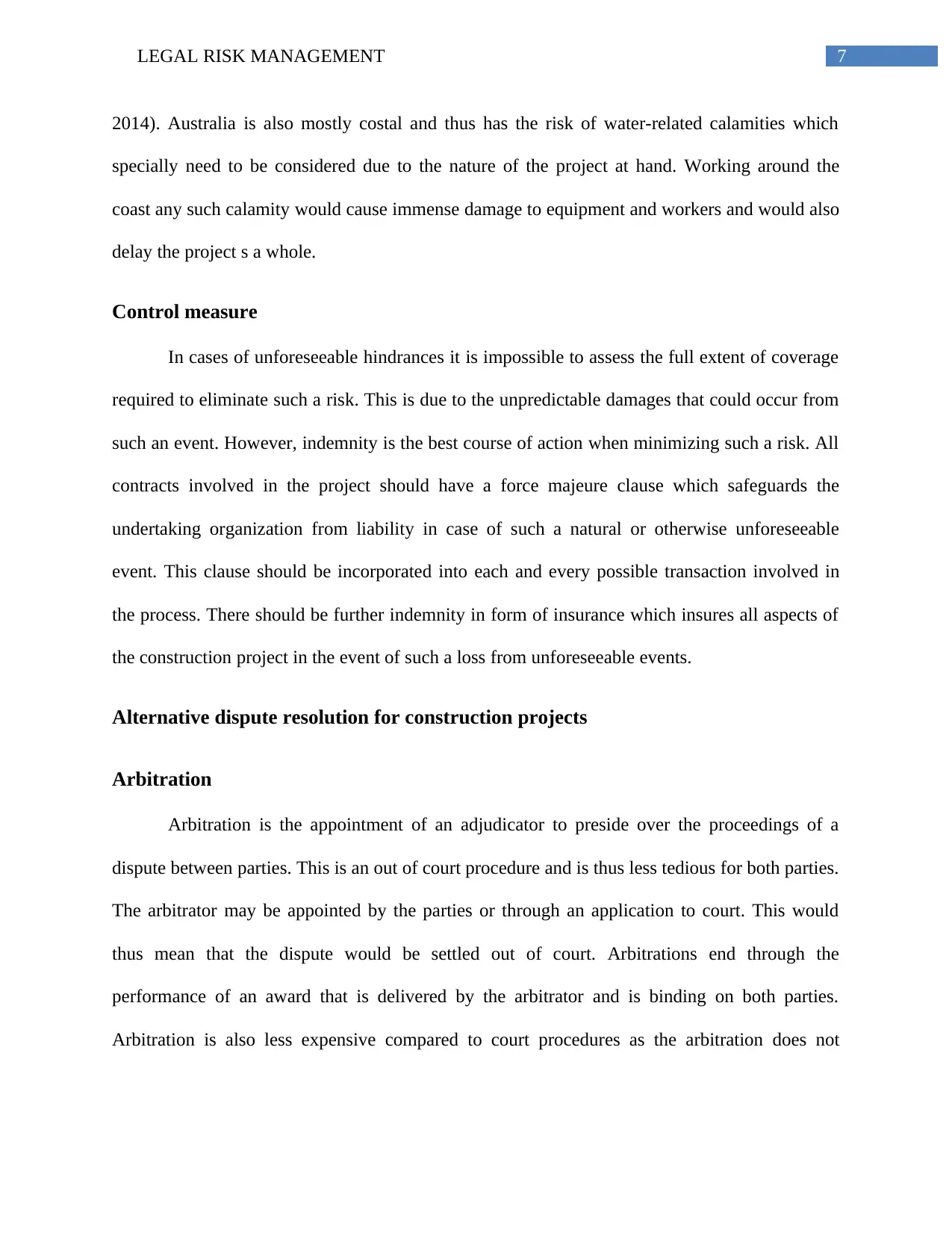
7LEGAL RISK MANAGEMENT
2014). Australia is also mostly costal and thus has the risk of water-related calamities which
specially need to be considered due to the nature of the project at hand. Working around the
coast any such calamity would cause immense damage to equipment and workers and would also
delay the project s a whole.
Control measure
In cases of unforeseeable hindrances it is impossible to assess the full extent of coverage
required to eliminate such a risk. This is due to the unpredictable damages that could occur from
such an event. However, indemnity is the best course of action when minimizing such a risk. All
contracts involved in the project should have a force majeure clause which safeguards the
undertaking organization from liability in case of such a natural or otherwise unforeseeable
event. This clause should be incorporated into each and every possible transaction involved in
the process. There should be further indemnity in form of insurance which insures all aspects of
the construction project in the event of such a loss from unforeseeable events.
Alternative dispute resolution for construction projects
Arbitration
Arbitration is the appointment of an adjudicator to preside over the proceedings of a
dispute between parties. This is an out of court procedure and is thus less tedious for both parties.
The arbitrator may be appointed by the parties or through an application to court. This would
thus mean that the dispute would be settled out of court. Arbitrations end through the
performance of an award that is delivered by the arbitrator and is binding on both parties.
Arbitration is also less expensive compared to court procedures as the arbitration does not
2014). Australia is also mostly costal and thus has the risk of water-related calamities which
specially need to be considered due to the nature of the project at hand. Working around the
coast any such calamity would cause immense damage to equipment and workers and would also
delay the project s a whole.
Control measure
In cases of unforeseeable hindrances it is impossible to assess the full extent of coverage
required to eliminate such a risk. This is due to the unpredictable damages that could occur from
such an event. However, indemnity is the best course of action when minimizing such a risk. All
contracts involved in the project should have a force majeure clause which safeguards the
undertaking organization from liability in case of such a natural or otherwise unforeseeable
event. This clause should be incorporated into each and every possible transaction involved in
the process. There should be further indemnity in form of insurance which insures all aspects of
the construction project in the event of such a loss from unforeseeable events.
Alternative dispute resolution for construction projects
Arbitration
Arbitration is the appointment of an adjudicator to preside over the proceedings of a
dispute between parties. This is an out of court procedure and is thus less tedious for both parties.
The arbitrator may be appointed by the parties or through an application to court. This would
thus mean that the dispute would be settled out of court. Arbitrations end through the
performance of an award that is delivered by the arbitrator and is binding on both parties.
Arbitration is also less expensive compared to court procedures as the arbitration does not
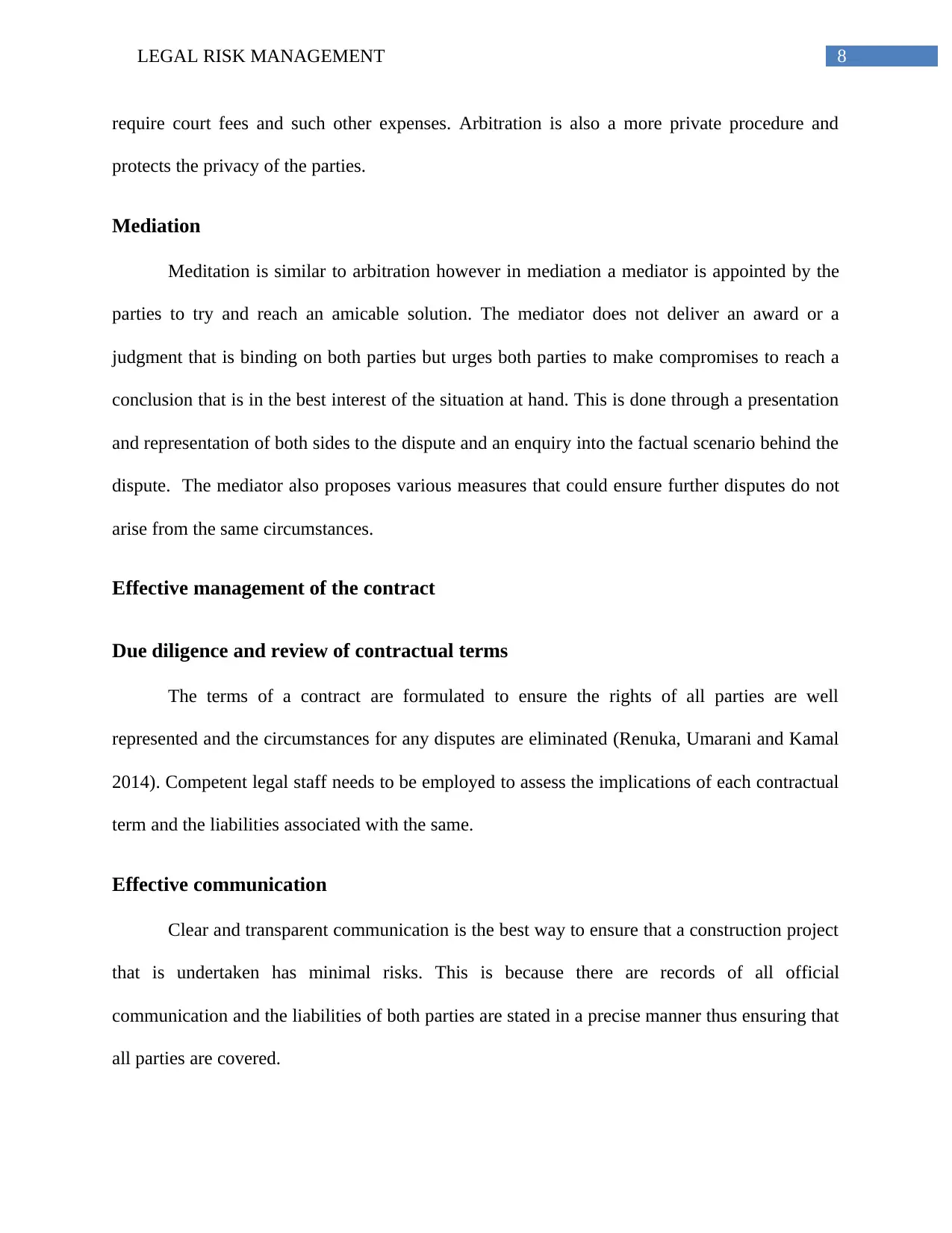
8LEGAL RISK MANAGEMENT
require court fees and such other expenses. Arbitration is also a more private procedure and
protects the privacy of the parties.
Mediation
Meditation is similar to arbitration however in mediation a mediator is appointed by the
parties to try and reach an amicable solution. The mediator does not deliver an award or a
judgment that is binding on both parties but urges both parties to make compromises to reach a
conclusion that is in the best interest of the situation at hand. This is done through a presentation
and representation of both sides to the dispute and an enquiry into the factual scenario behind the
dispute. The mediator also proposes various measures that could ensure further disputes do not
arise from the same circumstances.
Effective management of the contract
Due diligence and review of contractual terms
The terms of a contract are formulated to ensure the rights of all parties are well
represented and the circumstances for any disputes are eliminated (Renuka, Umarani and Kamal
2014). Competent legal staff needs to be employed to assess the implications of each contractual
term and the liabilities associated with the same.
Effective communication
Clear and transparent communication is the best way to ensure that a construction project
that is undertaken has minimal risks. This is because there are records of all official
communication and the liabilities of both parties are stated in a precise manner thus ensuring that
all parties are covered.
require court fees and such other expenses. Arbitration is also a more private procedure and
protects the privacy of the parties.
Mediation
Meditation is similar to arbitration however in mediation a mediator is appointed by the
parties to try and reach an amicable solution. The mediator does not deliver an award or a
judgment that is binding on both parties but urges both parties to make compromises to reach a
conclusion that is in the best interest of the situation at hand. This is done through a presentation
and representation of both sides to the dispute and an enquiry into the factual scenario behind the
dispute. The mediator also proposes various measures that could ensure further disputes do not
arise from the same circumstances.
Effective management of the contract
Due diligence and review of contractual terms
The terms of a contract are formulated to ensure the rights of all parties are well
represented and the circumstances for any disputes are eliminated (Renuka, Umarani and Kamal
2014). Competent legal staff needs to be employed to assess the implications of each contractual
term and the liabilities associated with the same.
Effective communication
Clear and transparent communication is the best way to ensure that a construction project
that is undertaken has minimal risks. This is because there are records of all official
communication and the liabilities of both parties are stated in a precise manner thus ensuring that
all parties are covered.
⊘ This is a preview!⊘
Do you want full access?
Subscribe today to unlock all pages.

Trusted by 1+ million students worldwide
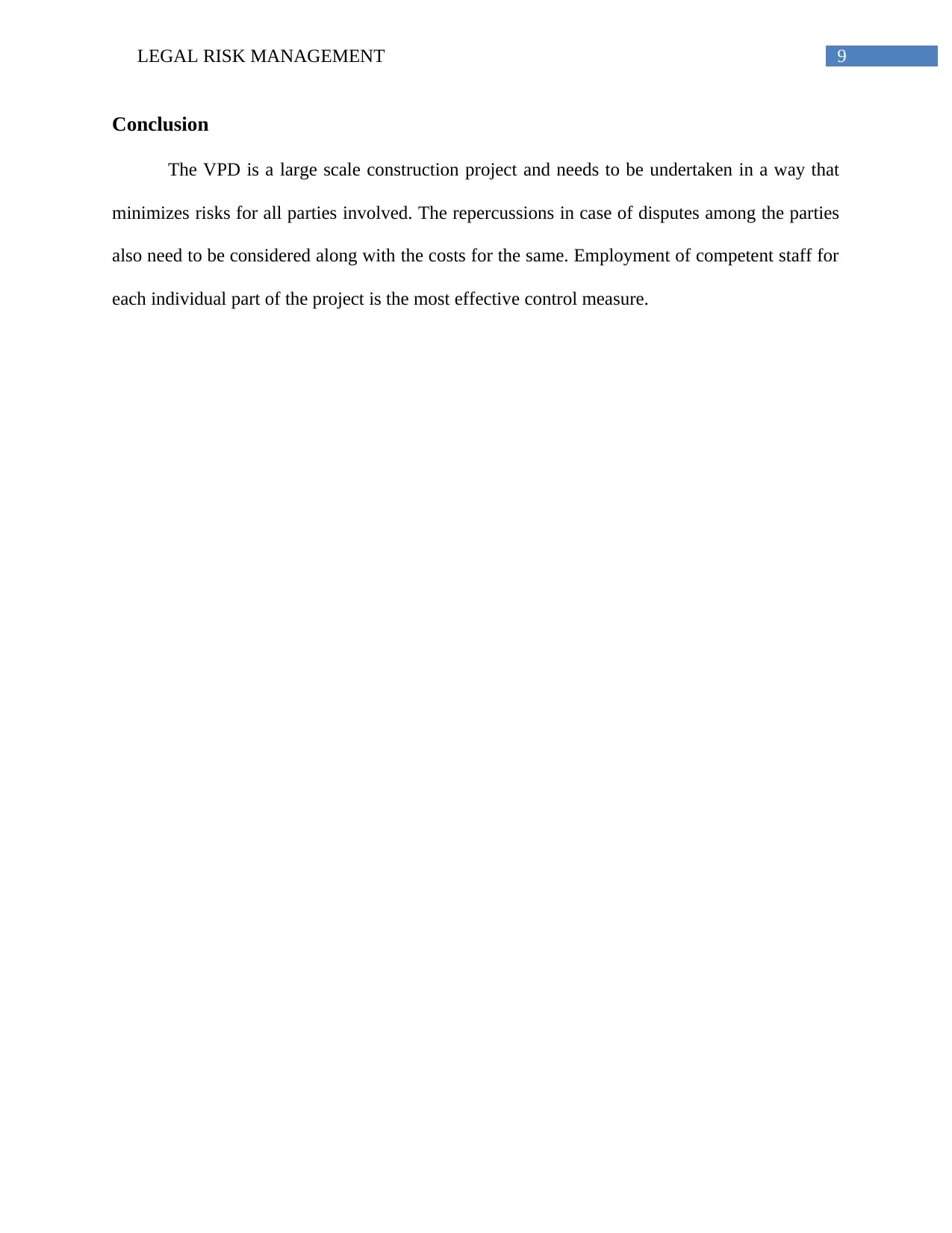
9LEGAL RISK MANAGEMENT
Conclusion
The VPD is a large scale construction project and needs to be undertaken in a way that
minimizes risks for all parties involved. The repercussions in case of disputes among the parties
also need to be considered along with the costs for the same. Employment of competent staff for
each individual part of the project is the most effective control measure.
Conclusion
The VPD is a large scale construction project and needs to be undertaken in a way that
minimizes risks for all parties involved. The repercussions in case of disputes among the parties
also need to be considered along with the costs for the same. Employment of competent staff for
each individual part of the project is the most effective control measure.
Paraphrase This Document
Need a fresh take? Get an instant paraphrase of this document with our AI Paraphraser
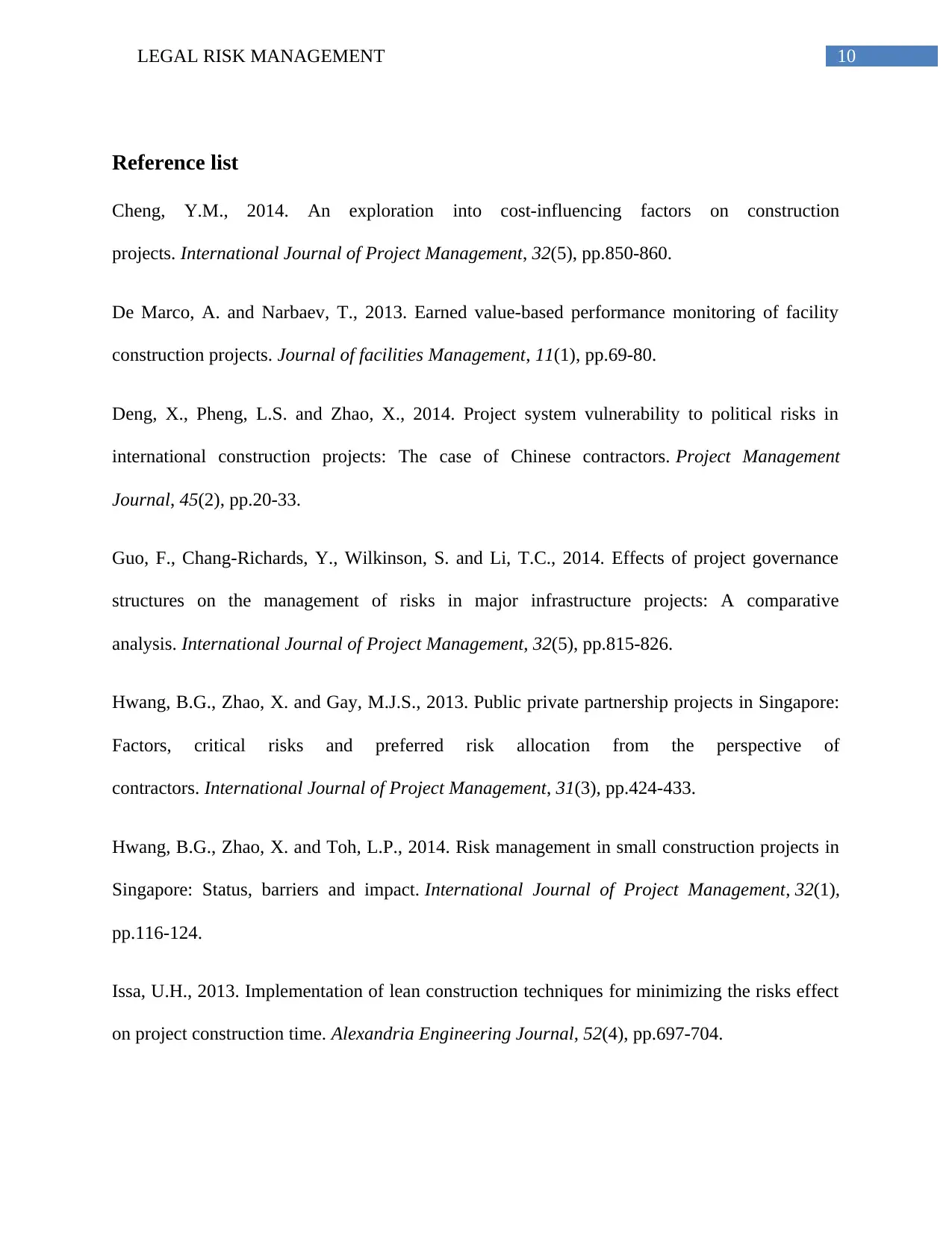
10LEGAL RISK MANAGEMENT
Reference list
Cheng, Y.M., 2014. An exploration into cost-influencing factors on construction
projects. International Journal of Project Management, 32(5), pp.850-860.
De Marco, A. and Narbaev, T., 2013. Earned value-based performance monitoring of facility
construction projects. Journal of facilities Management, 11(1), pp.69-80.
Deng, X., Pheng, L.S. and Zhao, X., 2014. Project system vulnerability to political risks in
international construction projects: The case of Chinese contractors. Project Management
Journal, 45(2), pp.20-33.
Guo, F., Chang-Richards, Y., Wilkinson, S. and Li, T.C., 2014. Effects of project governance
structures on the management of risks in major infrastructure projects: A comparative
analysis. International Journal of Project Management, 32(5), pp.815-826.
Hwang, B.G., Zhao, X. and Gay, M.J.S., 2013. Public private partnership projects in Singapore:
Factors, critical risks and preferred risk allocation from the perspective of
contractors. International Journal of Project Management, 31(3), pp.424-433.
Hwang, B.G., Zhao, X. and Toh, L.P., 2014. Risk management in small construction projects in
Singapore: Status, barriers and impact. International Journal of Project Management, 32(1),
pp.116-124.
Issa, U.H., 2013. Implementation of lean construction techniques for minimizing the risks effect
on project construction time. Alexandria Engineering Journal, 52(4), pp.697-704.
Reference list
Cheng, Y.M., 2014. An exploration into cost-influencing factors on construction
projects. International Journal of Project Management, 32(5), pp.850-860.
De Marco, A. and Narbaev, T., 2013. Earned value-based performance monitoring of facility
construction projects. Journal of facilities Management, 11(1), pp.69-80.
Deng, X., Pheng, L.S. and Zhao, X., 2014. Project system vulnerability to political risks in
international construction projects: The case of Chinese contractors. Project Management
Journal, 45(2), pp.20-33.
Guo, F., Chang-Richards, Y., Wilkinson, S. and Li, T.C., 2014. Effects of project governance
structures on the management of risks in major infrastructure projects: A comparative
analysis. International Journal of Project Management, 32(5), pp.815-826.
Hwang, B.G., Zhao, X. and Gay, M.J.S., 2013. Public private partnership projects in Singapore:
Factors, critical risks and preferred risk allocation from the perspective of
contractors. International Journal of Project Management, 31(3), pp.424-433.
Hwang, B.G., Zhao, X. and Toh, L.P., 2014. Risk management in small construction projects in
Singapore: Status, barriers and impact. International Journal of Project Management, 32(1),
pp.116-124.
Issa, U.H., 2013. Implementation of lean construction techniques for minimizing the risks effect
on project construction time. Alexandria Engineering Journal, 52(4), pp.697-704.
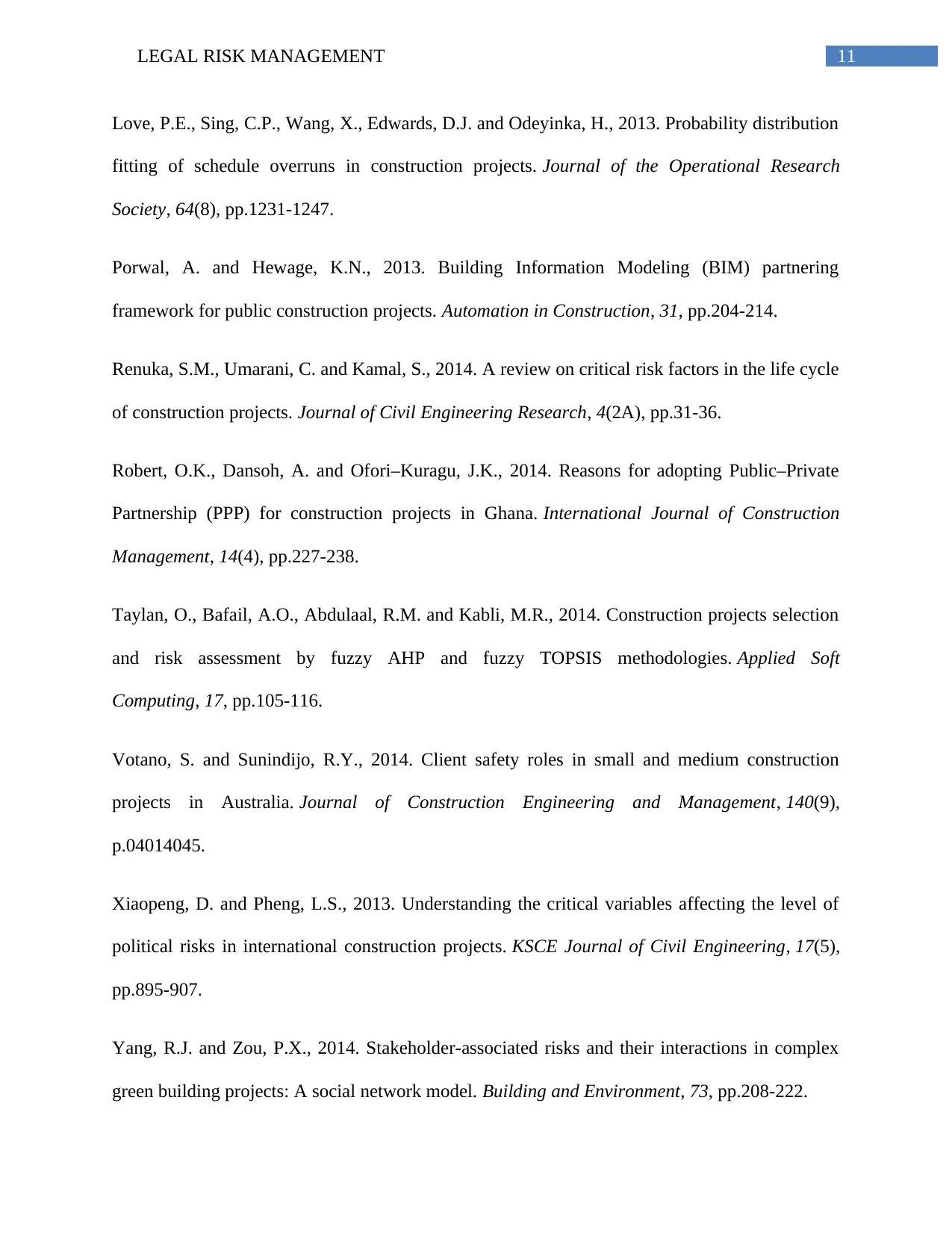
11LEGAL RISK MANAGEMENT
Love, P.E., Sing, C.P., Wang, X., Edwards, D.J. and Odeyinka, H., 2013. Probability distribution
fitting of schedule overruns in construction projects. Journal of the Operational Research
Society, 64(8), pp.1231-1247.
Porwal, A. and Hewage, K.N., 2013. Building Information Modeling (BIM) partnering
framework for public construction projects. Automation in Construction, 31, pp.204-214.
Renuka, S.M., Umarani, C. and Kamal, S., 2014. A review on critical risk factors in the life cycle
of construction projects. Journal of Civil Engineering Research, 4(2A), pp.31-36.
Robert, O.K., Dansoh, A. and Ofori–Kuragu, J.K., 2014. Reasons for adopting Public–Private
Partnership (PPP) for construction projects in Ghana. International Journal of Construction
Management, 14(4), pp.227-238.
Taylan, O., Bafail, A.O., Abdulaal, R.M. and Kabli, M.R., 2014. Construction projects selection
and risk assessment by fuzzy AHP and fuzzy TOPSIS methodologies. Applied Soft
Computing, 17, pp.105-116.
Votano, S. and Sunindijo, R.Y., 2014. Client safety roles in small and medium construction
projects in Australia. Journal of Construction Engineering and Management, 140(9),
p.04014045.
Xiaopeng, D. and Pheng, L.S., 2013. Understanding the critical variables affecting the level of
political risks in international construction projects. KSCE Journal of Civil Engineering, 17(5),
pp.895-907.
Yang, R.J. and Zou, P.X., 2014. Stakeholder-associated risks and their interactions in complex
green building projects: A social network model. Building and Environment, 73, pp.208-222.
Love, P.E., Sing, C.P., Wang, X., Edwards, D.J. and Odeyinka, H., 2013. Probability distribution
fitting of schedule overruns in construction projects. Journal of the Operational Research
Society, 64(8), pp.1231-1247.
Porwal, A. and Hewage, K.N., 2013. Building Information Modeling (BIM) partnering
framework for public construction projects. Automation in Construction, 31, pp.204-214.
Renuka, S.M., Umarani, C. and Kamal, S., 2014. A review on critical risk factors in the life cycle
of construction projects. Journal of Civil Engineering Research, 4(2A), pp.31-36.
Robert, O.K., Dansoh, A. and Ofori–Kuragu, J.K., 2014. Reasons for adopting Public–Private
Partnership (PPP) for construction projects in Ghana. International Journal of Construction
Management, 14(4), pp.227-238.
Taylan, O., Bafail, A.O., Abdulaal, R.M. and Kabli, M.R., 2014. Construction projects selection
and risk assessment by fuzzy AHP and fuzzy TOPSIS methodologies. Applied Soft
Computing, 17, pp.105-116.
Votano, S. and Sunindijo, R.Y., 2014. Client safety roles in small and medium construction
projects in Australia. Journal of Construction Engineering and Management, 140(9),
p.04014045.
Xiaopeng, D. and Pheng, L.S., 2013. Understanding the critical variables affecting the level of
political risks in international construction projects. KSCE Journal of Civil Engineering, 17(5),
pp.895-907.
Yang, R.J. and Zou, P.X., 2014. Stakeholder-associated risks and their interactions in complex
green building projects: A social network model. Building and Environment, 73, pp.208-222.
⊘ This is a preview!⊘
Do you want full access?
Subscribe today to unlock all pages.

Trusted by 1+ million students worldwide
1 out of 12
Your All-in-One AI-Powered Toolkit for Academic Success.
+13062052269
info@desklib.com
Available 24*7 on WhatsApp / Email
![[object Object]](/_next/static/media/star-bottom.7253800d.svg)
Unlock your academic potential
Copyright © 2020–2025 A2Z Services. All Rights Reserved. Developed and managed by ZUCOL.

